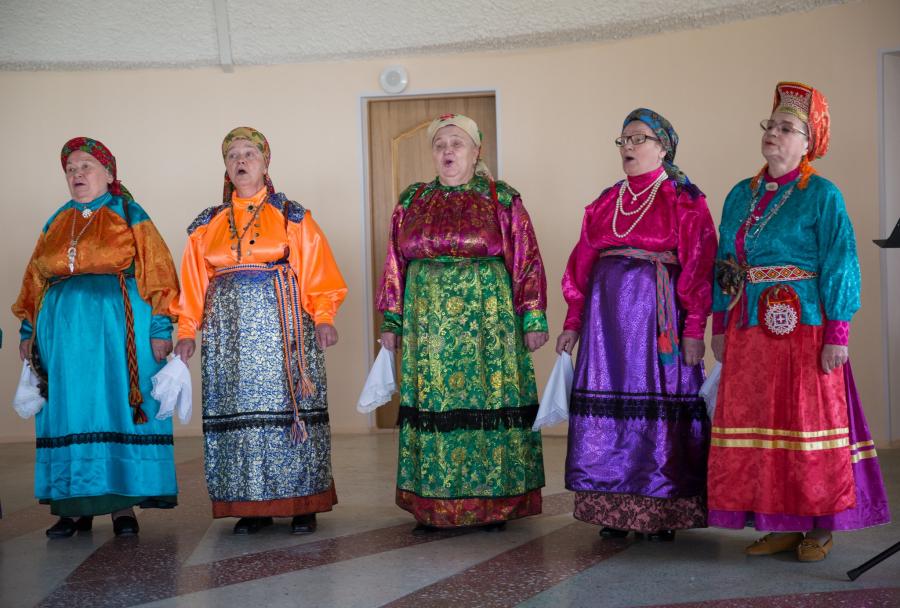The Vilyuy River, located in a remote area in the Sakha Republic of eastern Siberia, used to be crystal clear and full of fish. The people used to be strong and healthy, with the third longest life expectancy in the world. The fields and woods used to burst forth in a thick carpet of wild flowers and were filled with an orchestra of bird songs.
Now the Vilyuy River waters run red, and fish are scarce. The life expectancy has decreased in children and adults. The former carpet of flowers is scant sprinkling, and the forests come close to silent in spring. The Sakha call the river Buluu Khoton Ebee or "Vilyuy our might Grandmother," and they mourn her destruction.
Origins and Evolution
Turkic newcomers to the middle Lena River in northeast Siberia mingled with the indigenous Tungus (Evenk and Even) and Mongol tribes between the late 13th to early 17th centuries. They developed a distinct language, spiritual, material and social culture, and thus the Sakha ethnos formed, according to renowned Sakha ethnographer Anatoli Gogolve.
In the late 1500s some Sakha settled in the Vilyuy River Basin because they were attracted by its extensive pastures for grazing their herds. In 1628 Russian Cossacks "opened" the Vilyuy River, annexing the area to the State who immediately began collecting fur taxes from the indigenous peoples. This devastated the already overburdened inhabitants and they soon were both in debt and partial slaves to the local tribal chiefs.
During the Soviet Period, the authorities initiated "progress" in the Vilyuy regions, characterized by intensified farming and industrial exploitation. The State farm system introduced non-indigenous plant and animal breeds, replaced indigenous farming knowledge with Soviet centralized systems which emphasized production at the cost of sustainability, and concentrated the small settlements into massive State farm operations creating significant stress on the fragile northern ecosystem. Shortly after the break-up of central power, concerned citizens researched the real doings of the "great advancers of industrialization and agriculture."
Nuclear Contamination
Between 1974 and 1987 the government performed 11 underground nuclear tests in the Vilyuy regions. None of the Vilyuy residents knew of those explosions until in 1987 when an insubstantial newspaper article announced that underground nuclear tests were being performed and that the radioactivity levels were "normal." Later, concerned inhabitants questioned the State - who maintained for years that there were no accidents - about such activity. After persistent citizen inquiry they acknowledged that two of the 11 had catastrophic above-ground fall-out. The president of the Sakha Republic, Mikhial Nikolaev, was quoted in the Moscow News to have said, "For the Sakha who for centuries have lived in harmony with nature, the Vilyuy tragedy is similar to the Chernobyl one - an irreversible change has occurred in the entire Vilyuy ecosystem. Earlier unknown diseases have appeared in the indigenous populations and the riverside inhabitants are sick more often now than in the past."
Diamonds
On August 21, 1954, when geologist Lorisa Popugaeva discovered the first kimberlite (diamond) pipe, the Sakha people were told, with the help of Soviet propaganda, to rejoice this newly-discovered wealth potential. Poster art from the 1960s depicts a choron (a traditional Sakha goblet) turned on its side and spilling out diamonds. Ironically, the Sakha believe that a spilled choron foretells disaster. They were right.
As a result of unmonitored mining activities, the Vilyuy river suffered severe heavy metal and phenol contamination. Although the diamond company claims to contain those toxins now, initial contamination severely changed the river ecosystem from a prime fish habitat and a source of safe drinking water to a habitat where only "trash" species of fish thrive and water is not potable. Now, with no alternatives, most riverside villages continue to use its water for drinking, watering their livestock and gardens. In the Suntar region between the years of 1978 and 1993 there was a marked increase in disease, including higher rates of cancer and birth deformities, traceable to the industrial pollution in the Vilyuy regions.
Vilyuy Gydro-Electric Stantsia (GES)
In the late 1960s the government built the first hydroelectric power plant on permafrost to supply sufficient electricity for diamond processing. At the time, the Vilyuy residents applauded the arrival of both abundant and inexpensive electricity and the much needed local jobs that the plant officials promised them.
Today 95% of highly sought jobs are taken by workers from outside the Sakha Republic, and the cost of electric energy is high. The artificial sea that was creaed by the dam flooded 965 square miles, including 5,700 acres of prime pasture and 335,000 acres of woodlands. Because the area was not cleared prior to flooding, the anaerobic decomposition of trees and shrubs resulted in phenola and copper contamination of the Vilyuy watershed system. The reservoir and hydrostations have changed the watershed's natural ebb and flow patterns, ruining habitat for numerous fish and animals. Input water originates from the cold reservoir bottom and thus lowered the average temperature of river water by 8°C. The village of Toy-Khaya was flooded, forcing 600 people to relocate. One resident refused to leave and drowned in his home. To this day most of the evacuated residents do not have adequate housing that was initially promised by the authorities.
The huge mass of this artificial sea has brought about an overall warming effect to the Vilyuy regions averaging 5-6°C. Spring and fall begin two or three weeks later and the regions are subject to high winds as turbulence builds across the reservoir's vast surface area. These climatic changes are a major disruption to the Sakha who must make the most of a short growing season to cut enough hay to over-winter their cattle for nine months.
"Before the hydrodam there was an absolute abundance of water, especially in springtime; the river would swell to the brim and more so. The waterfowl came in such numbers that you couldn't see the blue sky through the mass of birds. Now the birds fly through in a trickle here and there." (Vilyuy resident)
In 1985 construction of the third GES began that will flood more valuable lands and threaten further contamination. Company officials cleared the area once, but due to economic hardships, construction has been halted and the trees and shrubs are growing back. There are questions about whether they can afford to proceed with construction, and if they can clear the area again.
Cosmic Rockets
Since 1958, the Vilyuy regions have been the recipient of the second stage drop-off of space exploration rockets launched from the Bikanur Cosmodrome in Kazakhstan. The shed rocket parts emit highly toxic gases which continue to contaminate the taiga (northern forests) and indigenous settlements. Numerous Sakha hunters have died after closely examining what they thought were UFOs or other harmless debris. The local Sakha link this to the rise of cancer rates and to unexplainable herds of dead animals found in the taiga.
The Social Factor
Changes in lifestyle and political structure also play a part in the environmental and cultural deterioration of the Vilyuy regions. The work ethnic has changed from "every one for the collective" to "every one for themselves." Prices continue to rise and jobs are scarce. In the nearby industrial towns, temporary workers receive 10-15 times the pay of village inhabitants. Prices for consumer goods run about 50%-75% lower, and they enjoy such luxuries as running water, septic and sewer systems, centralized heat, paved streets, well-stocked stores, and medical facilities. Although natural gas is abundant, the government is reticent to tap the endless natural gas reserves and install piping for domestic heating. This leaves the villagers with no choice but to heat with wood, further depleting the Vilyuy regions' dwindling forest reserves. These reserves are also threatened by summer forest fires that are mostly left to burn out (due to lack of money), destroying hundreds of thousands of acres each year.
Seeds of Hope
In the past few years there have been signs of local concern and action. Since 1990 ecology and Sakha culture have been taught as part of the main school curriculum. In 1993 a concerned citizen wrote in a regional paper: "It is clear that the Vilyuy ecological problems cannot be tackled by any single method or administrative unit. One key aspect is the rise in ecological consciousness of the Vilyuy populations, and the time is ripe for this with the present revival of Sakha traditions, values, and the indigenous stewardship relation to nature."
In 1994 the Elgai Nature Museum, located on the Vilyuy River, assumed the status as Regional Ecological Museum Center. In 1995 the Elgai Nature Museum staff and the Vilyuy Education Project (a special project of the MacArthur Foundation) wrote, published, and disseminated 5,000 copies of a citizen's action guide to ecology throughout the five Vilyuy regions. The Ministry of Education, in response to the urgent need for environmental education materials in the native Sakha language, provided funding for printing an additional 3,000 copies of the handbook so it could be distributed throughout the Sakha Republic. The Vilyuy Education Project also transformed one of the museum rooms into a hands-on ecology room. The Vilyuy Committee, a regional grassroots organization, began their work in 1989. The committee held many meetings in the early days and has slowly moved into a more action-oriented role. They now are involved in lobbying and citizen education.
New Mines and Minds
Today, in the Vilyuy Regions, there are six operating diamond pipes of a reported 600 potential sites. In 1995 the diamond industry officials announced plans to open new mines to avoid bankruptcy. The Botubinski, the first such site, described as the biggest diamond column in the entire Vilyuy region, is located adjacent to several Sakha villages. The local inhabitants are concerned that the same environmental and cultural damage caused by the earlier mines will result in their area.
"Diamonds for the Sakha," a new two-year initiative of the MacArthur Foundation, is working closely with Pyoter Martinev, head of the Vilyuy Committee and other concerned citizens. The project's objective is to assess past, present, and future diamond mining activity in the Vilyuy regions and formulate an environmentally, economically, and culturally sustainable plan. In summer 1996 the research team consisting of one American and two Sakha traveled to the villages adjacent to the new mines. The villagers live on the Markha River, a major tributary of the Vilyuy and down-river from Udachni and Aikhal, two main diamond mining cities. Already, children are born with never before seen birth defects. In Malakhay, a town of 3,000, 20 houses stand empty, abandoned by families afraid of the environmental effects of living there. Official delegations from the mining industry come regularly to inform them of the new mine work they are doing. They assure them that they are only doing preliminary measuring and when they do start mining that they will use environmentally safe techniques. They promise jobs for their children and economic growth for the region. The Sakha are skeptical.
We also traveled to Mirny, the diamond mining center, to speak with officials about their future plans. They feel certain that mining will immediately follow the preliminary assessment at Botubinski.
The situation is urgent. The Vilyuy Sakha need a way out. Their river region is the economic backbone of the entire Sakha Republic, an area twice the size of Alaska. It seems inevitable that diamonds will continue to be mined for decades to come. However, the question is whether local action similar to that of Martinev and the Vilyuy Committee can convince the administration to apply a proper system of environmental controls and make other assurances to safeguard the Sakhas' livelihood and their tradition of stewardship to their Grandmother Vilyuy.
Article copyright Cultural Survival, Inc.



